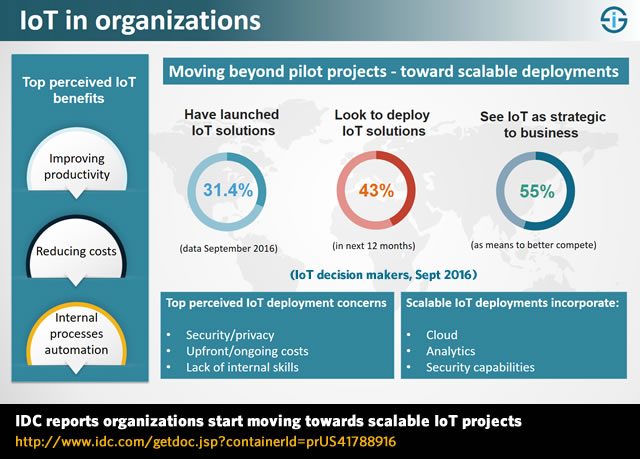An increasing number of organizations is pivoting away from Internet of Things (IoT) proof of concepts and entering the next stage
Depending on the industry, many organizations initially started with IoT pilot projects. Whereas manufacturing operations, utility companies and oil and gas firms, to name a few first movers, often already have gone beyond these pilots, others haven’t.
Yet, it seems that an increasing number of organizations is now entering that stage beyond pilot projects toward scalable deployments and even larger-scale IoT projects in other industries as well, not just in the Industrial Internet of Things.
In a 2016 Global IoT Decision Maker Survey, IDC found that 31.4 percent of organizations which participated in the research have launched Internet of Things solutions. An additional 43 percent of respondents said they looked to deploy an IoT solution in the next 12 months. Do note that many remain stuck in the pilot stage, however, and that IDC mainly looks at large enterprises.
31.4% of organizations have launched IoT solutions. An additional 43% looks to deploy one in the next 12 months
Benefits of Internet of Things deployments from the perspective of decision makers
Among the top benefits of IoT from the perspective of enterprise IT, IoT executives, and business decisions makers, better competition capabilities rank high with 55 percent of respondents seeing IoT as strategic to their business as a means to compete more effectively.

However, this doesn’t mean that external, customer-facing solutions are the key drivers of IoT deployments. The focus is rather internal and on operations with the improvement of productivity, cost reductions and the automation of internal processes being seen as top benefits of IoT initiatives.
Obviously automation (and optimization) of specific processes and improvement of productivity in many cases have an impact on the customer side (and that of other stakeholders) or are even done with the customer/partner in mind.
IoT concerns, “ownership” and decision/buying dynamics
Looking at the concerns, security/privacy and upfront/ongoing costs remain at the top. However, lack of internal skills has joined that list of major concerns.
The Internet of Things also needs technologies, partners and internal stakeholders who buy them.
Two important things we want to mention and comment on from this perspective of technology partners and decisions patterns:
1. Decisions are driven by the business
Whereas the strategy, budget and support questions led to discussion between line of business (LOB) execs and CIOs, this race seems to be over as the decisions are in the hands of the business. This is indeed also what we hear in the market: Internet of Things projects are driven by the business and IT and OT integration is crucial.
2. A changing IoT solutions partner ecosystem
Vendors who lead with an integrated cloud and analytics solution are the ones who will be considered as critical partners in an organization’s IoT investment, says Carrie MacGillivray, VP Mobility and Internet of Things at IDC. She also notes that traditional hardware vendors are slipping down the charts and integrators become more important.
A sidenote here: the landscape is changing and the ways the revenues are split among vendors are indeed changing. Certainly in industrial applications, and with the integration of IT and OT in mind, Internet Of Things projects are often additional business for vendors and integrators.
And some vendors are being contacted more directly by end customers, even if they have a hardware background. However, it needs to be said that these are typically vendors who also have the cloud and analytics solution, as well as the IoT expertise.
A scalable Internet of Things deployment includes security

To conclude a note on the difference between pilot projects and scalable deployments.
While it’s easy to imagine the differences (testing the waters versus getting it truly done at scale) we want to zoom in on what IDC means by scalable deployments. We quote: “the market is pivoting away from proof of concept projects to scalable Internet of Things (IoT) deployments that are incorporating cloud, analytics, and security capabilities“.
The reason why we mention it is because embedded and advanced security is an inherent part of a scalable deployment and of any IoT business model as we mentioned earlier.
Recent events and ongoing security challenges show this is really critical. Therefore it’s good that security and privacy remain top of mind when it boils down to concerns.
More in the press release.
Top image: Shutterstock – Copyright: Zapp2Photo – All other images are the property of their respective mentioned owners.


